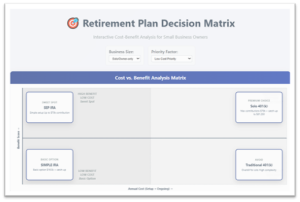Small business owners wear many hats, and retirement planning is often pushed to the bottom of the priority list. But choosing the right retirement savings vehicle can unlock valuable tax advantages, support employee retention, and align your long-term personal and business financial goals. Whether you’re a solo entrepreneur or a firm with a growing headcount, understanding your retirement plan options is crucial.
To help with that decision, we’ve created a retirement plan matrix that compares core options based on business size and priority. Every business is unique, and the right plan should match your objectives, cash flow, and staffing structure.
Explore the interactive diagram here → View Interactive Diagram
Use the drop-down menu to select your Business Size and Priority Factor

Key Considerations When Choosing a Plan:
-
Business size and structure: Sole proprietors have different needs than partnerships or corporations.
-
Employee demographics: Younger employees may value Roth contributions and portability, while older ones may prioritize higher contribution limits.
-
Tax strategy: Consider how each plan affects both business and personal tax liabilities.
-
Growth outlook: Plans should be scalable as your business grows.
-
Administrative capacity: Some plans require more compliance and recordkeeping than others.
-
Cost and value: Balance administrative burden with tax savings and employee engagement benefits.
-
SEP IRAs (Simplified Employee Pension)
Best for: Sole proprietors or small businesses with few or no employees.
Benefits:
- Easy and inexpensive to set up and maintain.
- Contributions are tax-deductible for the business.
- High contribution limits: up to 25% of compensation or $70,000 in 2025 (whichever is less).
Drawbacks:
- Employer-funded only; employees are not permitted to contribute.
- Must contribute the same percentage of compensation for all eligible employees.
Setup Cost Estimate: Minimal — typically $0–$250 for basic custodial setup.
Ongoing Costs: None to very low.
- SIMPLE IRAs (Savings Incentive Match Plan for Employees)
Best for: Businesses with 100 or fewer employees.
Benefits:
-
Easy to establish and operate.
-
Employee and employer contributions are allowed.
-
The employer must either match up to 3% of compensation or make a 2% nonelective contribution.
-
Lower administrative burden than 401(k)s.
Drawbacks:
-
Lower contribution limits than 401(k)s: $16,500 in 2025, with a $3,500 catch-up for age 50+ or $5,250 for ages 60–63.
-
Limited plan design flexibility and investment options are available.
Setup Cost Estimate: $0–$500 depending on provider.
Ongoing Costs: Minimal; often covered by the custodian.
-
Solo 401(k)s (Individual 401(k)s)
Best suited for Owner-only businesses or those owned by an owner and their spouse.
Benefits:
-
High contribution potential: up to $70,000 in 2025 (plus $7,500 catch-up for age 50+, or $11,250 for ages 60–63).
-
Contributions as both employer and employee.
-
Optional Roth component.
-
Loans may be permitted.
Drawbacks:
Setup Cost Estimate: $250–$750 depending on plan provider and customization.
Ongoing Costs: $100–$500 annually depending on plan complexity and services.
-
Traditional 401(k) Plans
Best for: Growing businesses with employees who want to offer competitive benefits.
Benefits:
-
Higher employee contribution limits: $23,500 in 2025 (plus $7,500 catch-up for age 50+, or $11,250 for ages 60–63).
-
Employer match and profit sharing available.
-
Roth option and loan provisions possible.
-
Helps with recruitment and retention.
Drawbacks:
Setup Cost Estimate: $500–$10,000+ depending on plan features and provider.
Ongoing Costs: $1,000–$5,000+ annually, including TPA services, compliance testing, and participant communications.
The right retirement plan can significantly enhance your business’s financial strategy. Reach out to your team at Boyum Wealth Architects if you are considering implementing a retirement plan or want to take the next step beyond the core retirement plan options.